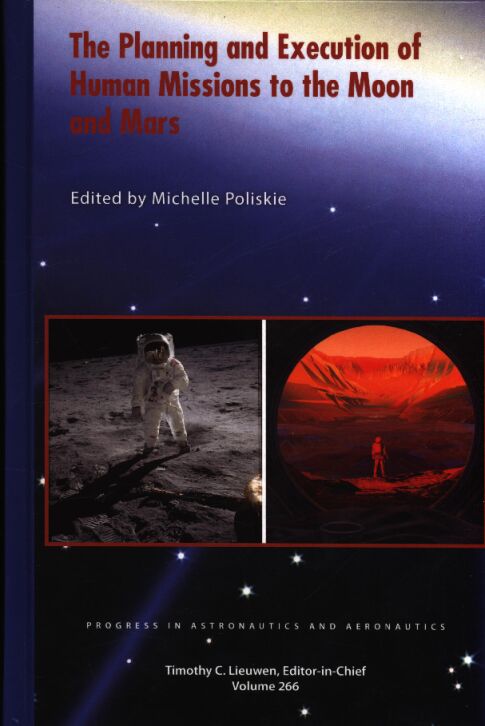书名:The planning and execution of human missions to the moon and mars
出版时间:2023
出版社:American Institute of Aeronautics and Astronautics, Inc.
分类号:航空、航天
页数:xxiii, 694 p.
摘要
Fascination with human exploration of Mars started at the birth of the space race in 1964. Soon after stepping foot on the Moon, the public and the scientific community immediately focused on Mars as the next horizon for exploration. In response, numerous articles and books have been published, describing the complex requirements and potential architecture for a human mission to Mars. This book strives to differentiate itself by reexamining enabling mission technology through a systems approach. Specifically, each technology is assessed as to how its degree of readiness impacts adjacent technology readiness, mission goals, and overall probability of mission success.
The last multidisciplinary technology readiness review occurred in 2015 when NASA unveiled the Evolvable Mars Campaign (EMC) [1, 2]. The EMC sets out a timeline for long- and short-term technological breakthroughs followed by a phase of technology validation and then a series of missions. Mission success and schedule adherence would be highly dependent on ensuring key enabling technologies were appropriately identified for development. In the Evolvable Mars Campaign, the technology breakthrough was divided into Earth Reliant and Proving Ground technologies. Generation of these technologies would enable an Earth Independent phase with the necessary technology to support a long-duration crewed mission to Mars.
The Earth Reliant area was highlighted for technology development and validation. In 2015, these types of technologies included [1]: • Long-duration, deep-space habitation systems • Next-generation space suits • Autonomous operations • Communications with increased delay • Human and robotic mission operations • Operations with reduced logistics capability • Integrated exploration hardware testing • Mitigation techniques for crew health and performance in micro-g • Acclimation from 0 g to low g • Acquisition of routine U.S. crew transportation to low Earth orbit (LEO)
The Proving Ground included technologies that were sufficiently developed and required only validation. In 2015, these included [1]: • SLS and Orion in deep space • Solar electric propulsion (SEP) systems • Long-duration, deep-space habitation systems • Mitigation techniques for crew health and performance in a deep space environment • In-situ resource utilization • Operations with reduced logistics capability • System design requirements for thermal protection and avionics reliability
Now, years later, this book reexamines these critical technologies and any limitations that will decrease the probability for a successful human mission to Mars. Each technology is reviewed by a subject matter expert highly recognized in their field. The intent of this volume is for the reader to walk away with an understanding of the geopolitical forces required to ensure appropriate resources to plan and execute a human mission to Mars, a scientific approach to the viability of these missions, and clear recommendations for areas of future technology development. These technologies will be evaluated based on NASA's goal to send humans to Mars in the 2030s [3-5].
Most importantly, these technology reviews should not be viewed as separate requirements. Instead, the architecture of this volume is designed to provide a clear understanding of the consequences of each enabling technology for one another and the overall potential for mission success. Themes explored in this book are: • Propulsion technology, including solar electric propulsion (SEP) and nuclear thermal propulsion (NTP) readiness and the consequences of propulsion strategy on mission architecture • Deep space radiation consequences on human anatomy and current radiation mitigation strategies • Current deep space communication strategy and its impact on guidance and control readiness • Space logistics and its impact on vehicle design and human factor requirements • The impact of in-space manufacturing on habitat development requirements • The impact of abort strategies and risk posture on mission deliverables and success
The book is organized into two sections. In the first set of chapters, we discuss the policy and program requirements for developing a mission architecture. In the second set, we discuss areas for technological advancement, the influence on other technologies, and the impact on mission architecture. The book concludes with a mathematical model to assist future study groups in performing trade space analyses to continually optimize program architecture based on technological readiness.
查看更多
目录
INTRODUCTION ⅹⅹⅰ
Planning Process for Current and Future Mars Exploration 1
The Journey to Mars: A Policy History 3
Program Management for Human Missions to Mars 15
Planetary Goals and Challenges for Human Exploration of Mars 53
Mission Architectures for Human Missions to Mars 81
Infrastructure for Human Exploration of Mars 115
Space Communications Architecture for Human Mars Exploration 119
Interplanetary Supply Chains and Space Logistics: Enabler of the Final Frontier 151
In-Space Manufacturing: Past, Present, and Future 195
Habitats for Space Exploration: Construction Materials, Design Concepts, and Future Directions 229
Vehicle Design and Critical Subsystems to Enable Human Exploration of Mars 267
Survival Design and Strategies for Aborted Crewed Missions for Mars Exploration 281
Propulsion Technologies for Crewed Vehicles to Mars 313
Reliability of Avionics and Complex Electronics for Crewed Spacecraft Exploration of Mars 371
Guidance, Navigation, and Control for Crewed Spacecraft to Mars 415
Thermal Protection for Exploration Vehicles 451
Human Health Risks Relevant to Deep Space Mars Exploration Missions 487
Environmental Control and Life Support Systems for Crewed Spacecraft Exploration of Mars 543
Mathematical Methods for Space Mission Planning and Architecture Design 597
查看PDF
查看更多
馆藏单位
中国科学技术信息研究所



